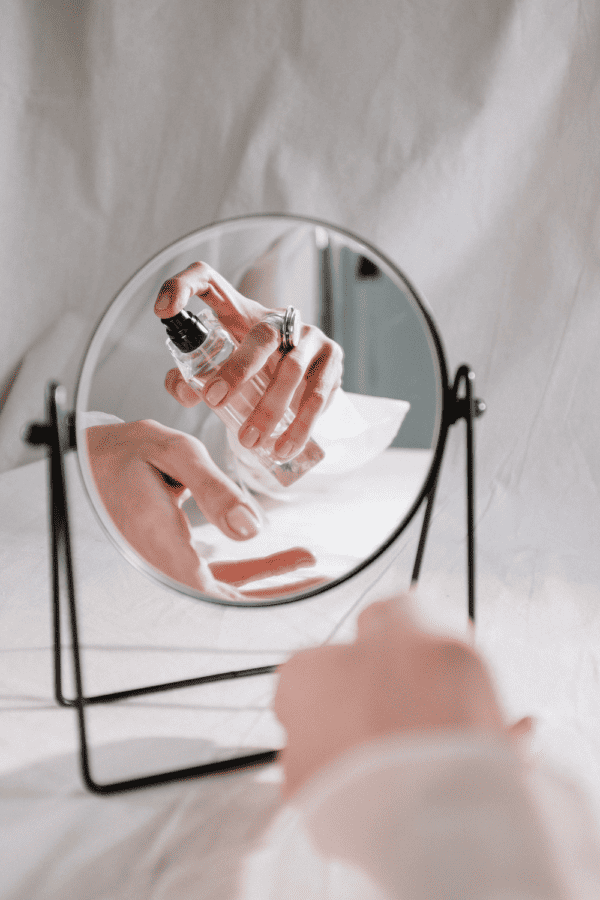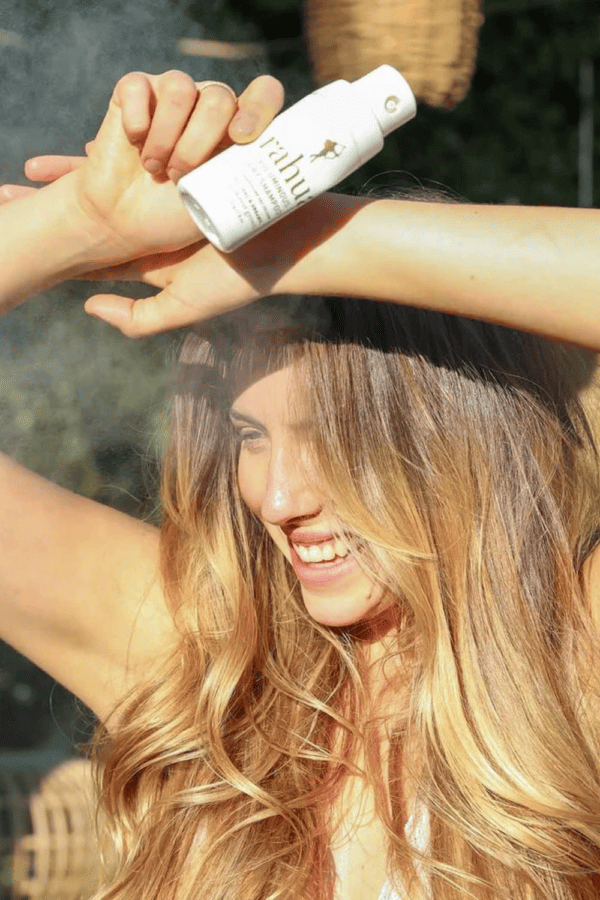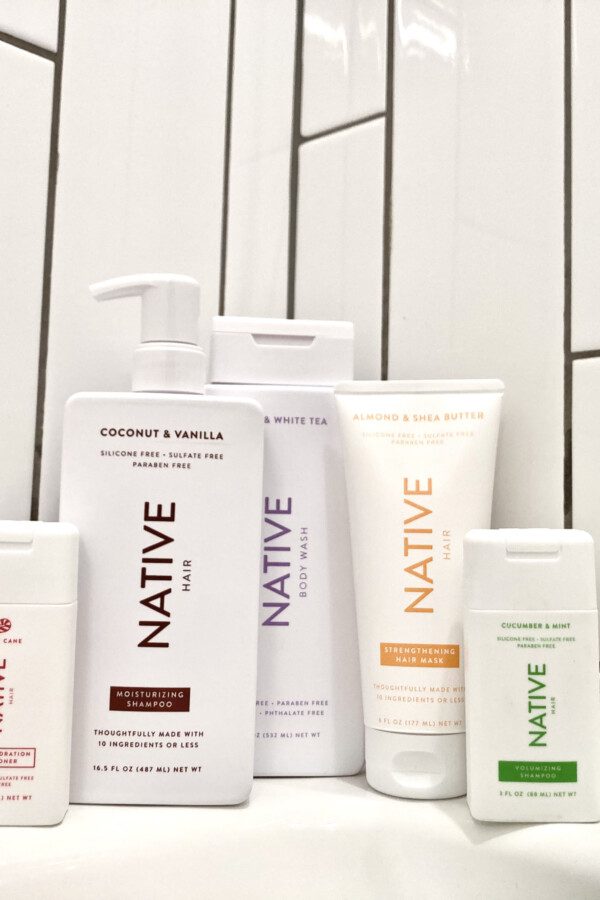Judging by St. Ives’ branding, you might automatically think it’s non-toxic/natural/eco-friendly, etc. It has a green leaf in the logo with a mountain behind it and its website is filled with nature-based imagery and words like “100% natural” and “#NATURERESET.”
But greenwashing runs rampant in the personal care industry, so to be honest: we’re skeptical.
So in this article, we’re taking a look at a number of St. Ives products and asking: Is St. Ives actually “all natural”? Are their popular products—like their lotion and apricot scrub—made with non-toxic ingredients? Is St. Ives good for your skin?
Table of Contents
- What Kind of Products Does St. Ives Make?
- St. Ives Ingredient Investigation
- Butylated Hydroxytoluene (BHT)
- PEGs, SLES, and Other Ethoxylated Ingredients
- Propylene Glycol
- Fragrance
- Lilial
- Parabens
- Petrolatum
- Artificial Dyes
- Triethanolamine (TEA)
- Methylisothiazolinone
- St. Ives Apricot Scrub Lawsuit
- More F.A.Q.s About St. Ives
- Who Owns St. Ives?
- Are St. Ives Products Vegan and/or Cruelty-Free?
- Did St Ives stop making lotion?
- Which is better: St. Ives or Aveeno?
- Better Brands to Use Instead of St. Ives
- Conclusion: Is St. Ives Good for Your Skin?
What Kind of Products Does St. Ives Make?
- Face Scrubs & Cleansers
- Lip Scrubs
- Face & Eye Sheet Masks
- Face Moisturizers
- Body Wash
- Body Lotion
- Acne & Blackhead Control Products
St. Ives Ingredient Investigation
When we first look up St. Ives on the Environmental Working Group’s (EWG) SkinDeep database, we see that St. Ives product scores range from 2 (which is considered safe) to 7 (not good; 10 is the highest). Most of the products fall in the “moderate” range, from 3 to 6. The SkinDeep database is not always 100% accurate, but it gives us a good general idea of where this brand likely stands in terms of ingredient safety.
Next, we looked at a number of St. Ives products—including a few different lotions, body washes, facial scrubs, and more—and pulled out some of the most commonly used problematic ingredients. In no particular order, here are some ingredients to take note of:
Butylated Hydroxytoluene (BHT)
BHT is often used as a preservative, but it’s a toluene-based ingredient. Toluene is a known volatile organic compound (VOC) which is an irritant that can affect the central nervous system, can be toxic to the kidneys and liver, and is a possible reproductive and/or developmental toxin. There are safer preservatives that can be used instead.
PEGs, SLES, and Other Ethoxylated Ingredients
Polyethylene glycol (PEG), sodium laureth sulfate (SLES), and other ethoxylated ingredients are very commonly used in personal care products for a wide variety of reasons. During manufacturing, these ingredients go through a process called ethoxylation, which requires two toxic ingredients: ethylene oxide and 1,4-dioxane. Ethylene oxide is known to cause multiple types of cancer and infertility, and 1,4-dioxane is a carcinogen. The problem with ethoxylated ingredients like PEG and SLES is that they’ve been found to be contaminated with these two chemicals.
Propylene Glycol
Propylene glycol is an irritant that has been associated with contact dermatitis.
Fragrance
Almost all of St. Ives products have “fragrance” listed on their ingredient labels. This is one of the most annoying ingredients used in personal care and cleaning products, and it also happens to be almost ubiquitous.
In the United States, companies are legally allowed to hide almost 4,000 different chemicals under the term “fragrance” or “parfum.” Some of these ingredients are perfectly safe, while others are known toxins. You can read more about this issue right here.
The good news is that with new legislation like the California Senate Bill 312, companies are beginning to be more transparent about the actual ingredients used in their fragrance products. All of St. Ives’ fragrance ingredients can be found on the SmartLabel database here.
The bad news is that you have to go digging for these ingredients (which most consumers are not going to do), the majority of them have really long and hard to pronounce names, and many of the ingredients have not been tested for safety. (Manufacturers are not required to test and/or prove that a certain ingredient is safe before using it in a product, and new ingredients are being developed all the time.) Although these new laws do require more transparency—which is certainly a step in the right direction—they do not put any demands on testing or safety of ingredients.
Lilial
This is a synthetic fragrance ingredient that is associated with contact dermatitis and allergies.
Body
Best Non-Toxic Moisturizer & Body Lotion Without Harmful Chemicals
A lot of what we rub on our skin gets absorbed into our bloodstream and then circulated through our bodies, so using body lotion without harmful chemicals matters.
Parabens
You’ve probably heard about parabens before—they often serve as fragrance ingredients, preservatives, and more. Although parabens are often hidden under the “fragrance” label, St. Ives actually lists propylparaben in plain sight in their spray lotions. Parabens are endocrine disruptors, which means they mimic hormones and lead to things like cancer and fertility issues.
Petrolatum
This is a petroleum-derived product, which is your first indication that it’s probably not great for human or environmental health. Although it’s not the most worrisome ingredient when used on its own in small doses, it can be contaminated with toxic chemicals called polycyclic aromatic hydrocarbons (PAHs).
Artificial Dyes
Some dyes and colorants are a lot safer than others, and St. Ives uses several different types of synthetic dyes that are linked to things like allergies and organ toxicity. There are various contamination concerns when it comes to colors and dyes as well.
Triethanolamine (TEA)
TEA and other ethanolamine compounds (MEA, DEA, etc.) are used for various reasons in soaps and cleansers but are linked to organ toxicity and cancer.
Methylisothiazolinone
This is a preservative ingredient that has been linked to neurotoxicity; irritation of the skin, eyes, and lings; and more. It’s been heavily restricted and/or banned in other places such as Japan, Canada, and Europe.
On their website, St. Ives says: “At St. Ives, we use 100% natural moisturizers, exfoliants, and extracts to bring the joy of nature into our cruelty free skin products to give you soft, refreshed skin that glows!” Their products are clearly not 100% natural in any way… So how can they get away with making this claim? Well, because there are unfortunately no laws that regulate this type of language or prohibit companies from making these kinds of claims without proof.

St. Ives Apricot Scrub Lawsuit
Back in 2017, St. Ives faced a lawsuit because of one of its most popular products: its Apricot Fresh Skin Scrub.
Two plaintiffs sued St. Ives, claiming that it actually caused skin damage because the crushed walnut powder actually created tiny tears in their skin, leading to infection. In 2018, the lawsuit was thrown out when the judge on the case agreed with Unilever (St. Ives’ parent company) that the plaintiffs didn’t have any proof of their claims.
So, are St. Ives scrubs bad? Are they too harsh? Those who have sensitive skin, eczema, or rosacea might be better off with a more gentle, scrub-free cleanser, but most people likely won’t have any problems with the exfoliating scrub powder. If you have any specific skin concerns, ask your dermatologist.
For us, the problem with St. Ives Fresh Skin Apricot Scrub is not so much with the crushed walnut powder, but rather with the fragrances, allergens, and other potentially problematic ingredients we talked about above.
More F.A.Q.s About St. Ives
Who Owns St. Ives?
St. Ives is owned by Unilever. You probably know some of Unilever’s other brands like Ben & Jerry’s, Vaseline, Axe, Dove, and more.
Are St. Ives Products Vegan and/or Cruelty-Free?
St. Ives is certified Cruelty-Free by PETA. Most of their products are free of animal-derived ingredients EXCEPT their Collagen & Elastin Moisturizer and Body Lotion, “which contain collagen and elastin derived from a marine source.”
Did St Ives stop making lotion?
Nope! St. Ives still makes a collection of body lotions and creams.
Which is better: St. Ives or Aveeno?
Unfortunately, Aveeno is another brand that’s guilty of marketing its products as “natural” when that might not always be the case. In truth, Aveeno’s products really run the gamut in terms of toxicity—some are safe while others contain known allergens, carcinogens, and more. For this reason, we can’t really recommend either of these brands on the whole.

Better Brands to Use Instead of St. Ives
Here are some brands that are similar to St. Ives in terms of products and aesthetic, but these brands are much safer and more transparent with their ingredients:
MyChelle (their Fruit Enzyme Scrub is a great replacement for St. Ives Apricot Scrub)
Weleda (unisex moisturizing body washes, lotions, lip balms, and more)
ATTITUDE (gender-neutral scented body washes, lotions, and more for the whole family)
True Botanicals (cleansers, masks, lotions, and more)
100% Pure (scented body lotions, cleansers, and more)
Beautycounter (face wash, shampoo, body wash, lotion, and more)
Blume (for acne-prone skin)
Conclusion: Is St. Ives Good for Your Skin?
While St. Ives does use some natural and nourishing ingredients like avocado oil, chamomile extract, and cacao seed butter, most of their ingredients are synthetic. Some of these synthetics are perfectly safe, but there are also plenty of ingredients that are linked to allergies, carcinogen contamination, organ toxicity, and more.
There are plenty of better skincare brands out there that use more natural and safer ingredients—and are more transparent about it!
Image Credits: Polina Kovaleva






Whatever happened to the “Truth in Advertising” regulation or law? I assume it is not enforced. There are many ads out there that are false.
There sure are. I believe there are just a LOT of loopholes in that law, along with a lack of regulation in many different areas when it comes to consumer products.